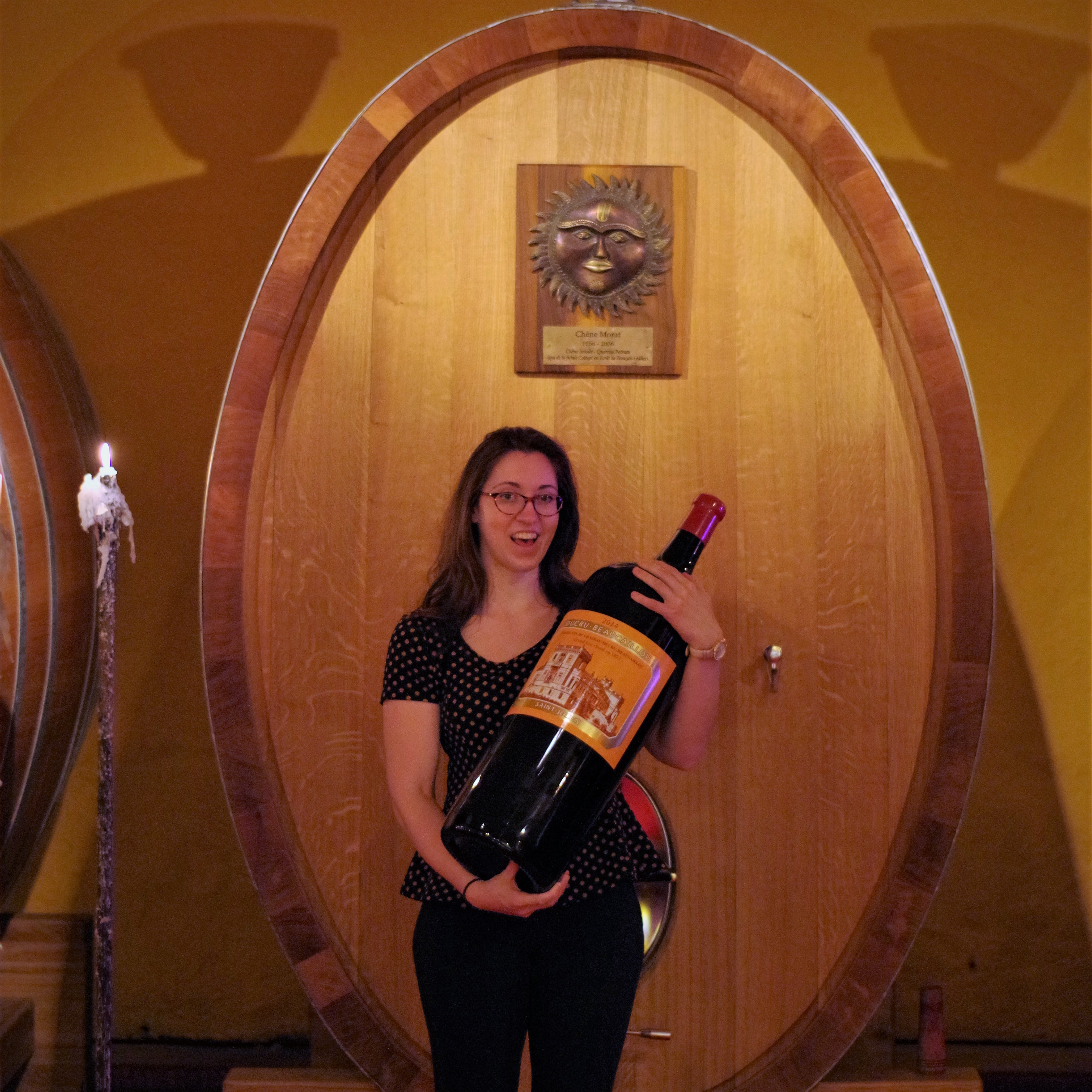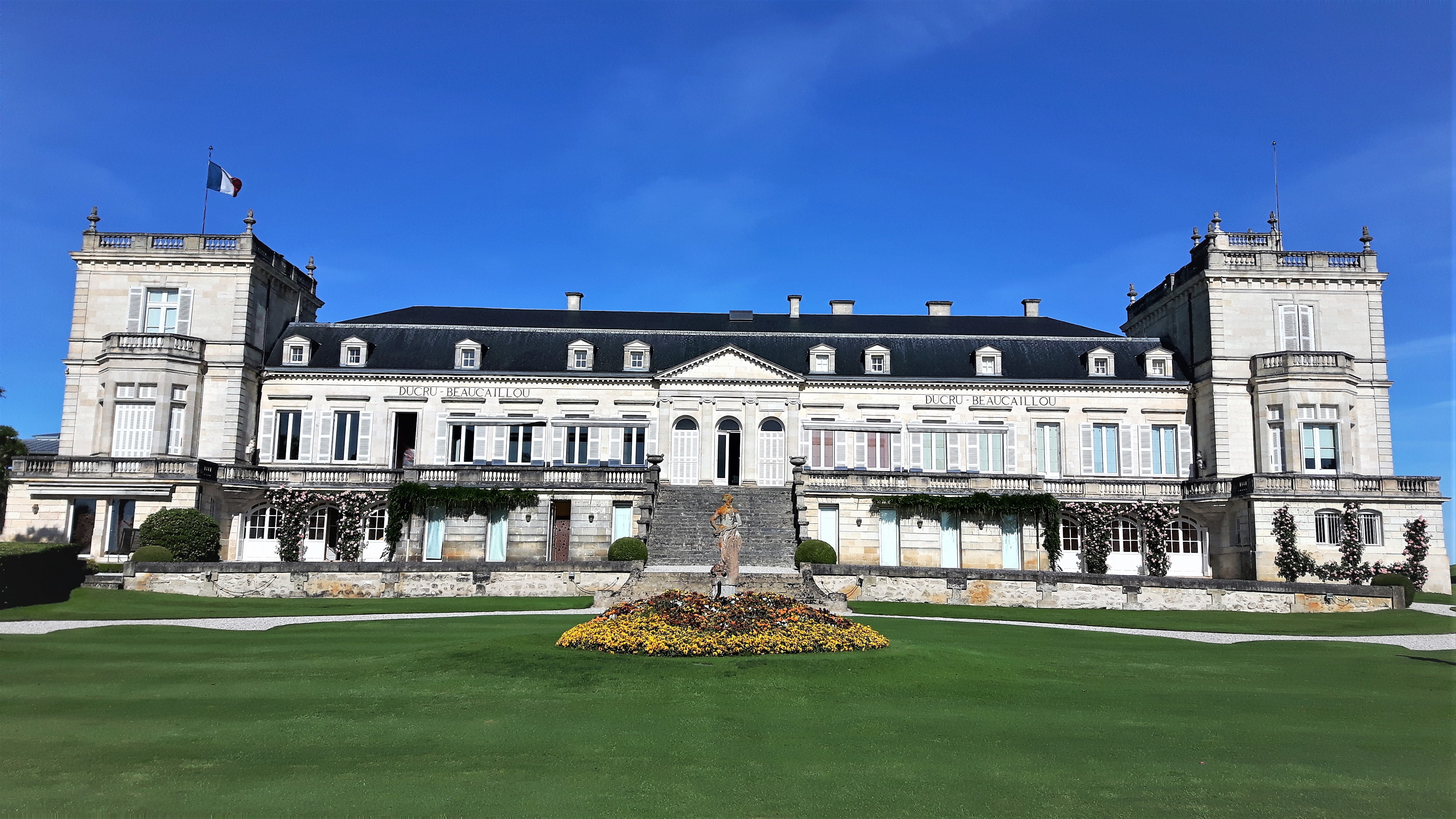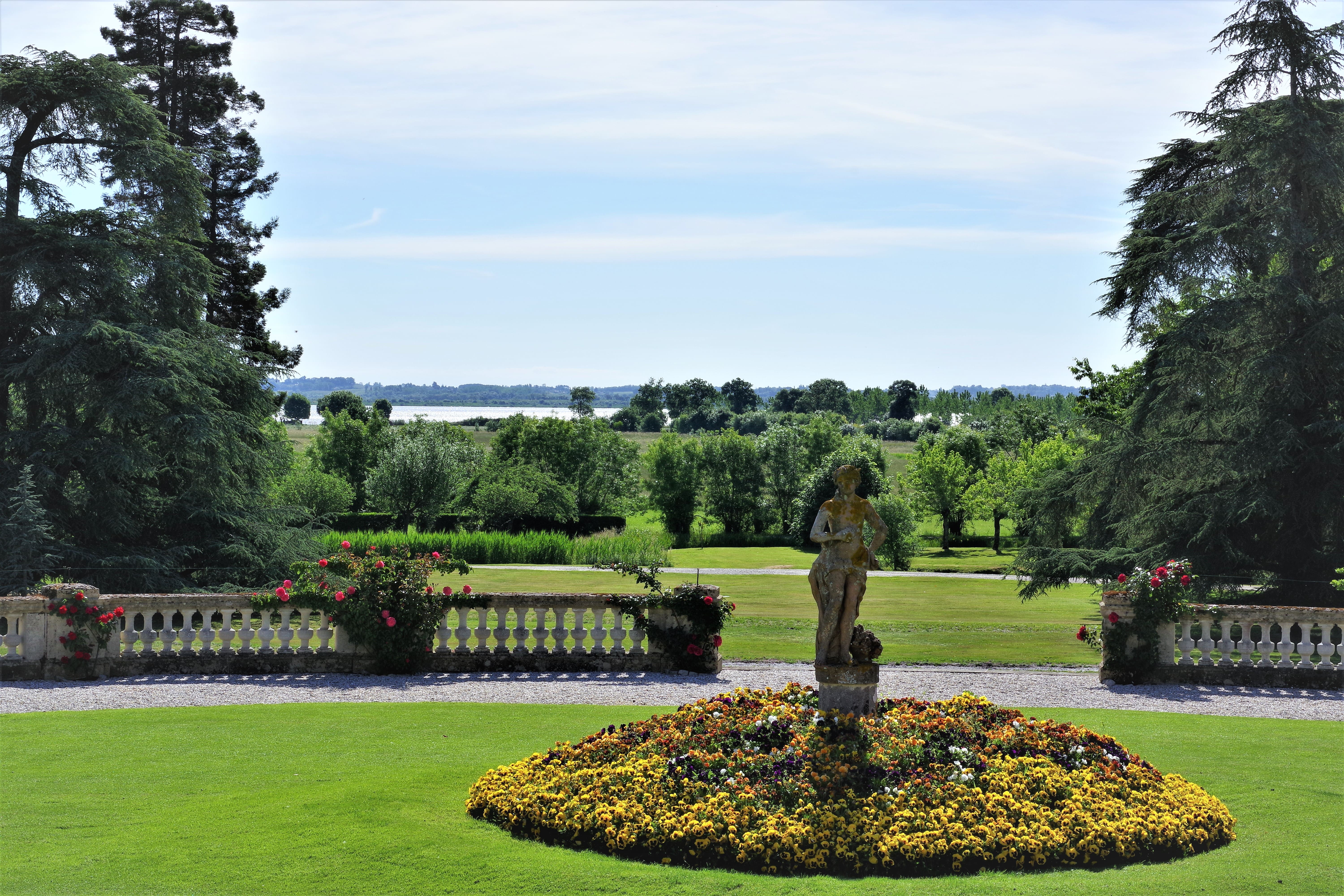Passing across Saint-Julien and Beychevelle, there’s one Château that stands out a lot, Château Ducru-Beaucaillou. It is perched on the slight hill where the sun shines the most, overlooking the river and the stone castle is just breathtaking. I mean, even more than the hundreds of other castles in the region. It has the honor to be one of the 14 second growths from the 1855 classification, but it is also considered as one of the rare “super secondsâ€. Now that’s a title that is appealing to me. My experience there as a modest visitor was quite a revelation and added a strong sense of place to the identity of this great wine. Why did no one told me about how truly fantastic this was going to be. I wasn’t ready.
I arrived ever so slightly late, some would say fashionably but I’m normally rooting for right on time. I was greeted by a very cheerful mister wearing a bright yellow apron. I learned rapidly that it was in fact Mr. René Lusseau, cellar master, accomplished winemaker and a product of the Médoc. He seemed to have something to say on every little detail. I know about the trouble he had with his Barrel cap supplier, the name of each worker that we crossed on our guided path, the perfect spots for pictures, that the lighted cat art in the barrel room did help to get rid of small unwanted visitor, the age of each tree, why he liked the traditional candles in the barrel room, etc. This man is a fun burst of information.
Here’s some of it.
Five families have succeeded as owners of the estate. As early as the 13th century, the Bergeron family was already receiving visitors at the estate and built a good reputation. In 1795, the estate was sold to Bertrand Ducru who gave his name to the estate along with the “beaux cailloux†or nice rocks just in between gravel and pebbles that are the basis of the terroir. The next reign was the Johnson family. Nathaniel Johnson with the help of Ernest David, the manager of the Left Bank estate, created the first solution to the recurrent Bordeaux mildew problem. It is now known as “Bouillie bordelaiseâ€. It was with a broken heart that he sold the estate to the Desbarats family after the economic crash of 1929. The Desbarats only kept the property for twelve years, unable to bring it back to its previous reputable state.
 The fifth and last family to own Château Ducru-Beaucaillou is the Borie Family. They also own Chateau Grand Puy Lacoste, Château Haut Batailley in Pauillac, Lalande-Borie produced from a vineyard purchased from Lagrange in the 70s as well as other vineyards in the region. Bruno Eugène Borie has joined his father in 1994 in the management team of the wine company. He was also Chairman of the “Conseil des grands crus classés†from 1997 to 1999.
The fifth and last family to own Château Ducru-Beaucaillou is the Borie Family. They also own Chateau Grand Puy Lacoste, Château Haut Batailley in Pauillac, Lalande-Borie produced from a vineyard purchased from Lagrange in the 70s as well as other vineyards in the region. Bruno Eugène Borie has joined his father in 1994 in the management team of the wine company. He was also Chairman of the “Conseil des grands crus classés†from 1997 to 1999.
Mister Borie, Master of the Castle is one of the few owners that uses the estate as habitation. The huge Palace has this homey feel to it. During my visit, he made a perfect grand entrance by slowly coming down the noble outdoor stairs towards us. He likes to meet and greet personally every visitor when possible as a perfectly proper host. We had a discussion on the situation of the estate, its evolution, his passion and some politics thrown in there. Well, the late Canadian Prime Minister Pierre Trudeau did pay the estate a visit before, apparently a good friend of the family.
A little while prior Bruno Borie came in charge of the estate, there was a big TCA contamination. In the cellars, all the bottles from 1986 up to 1994 were contaminated and destroyed. All other vintages remaining have been recorked to stay in perfect condition. It is now a problem of the past but still feel like a fresh wound when Mr. Lusseau talks about it.
Château Ducru-Beaucaillou is an admirable example of the St-Julien appellation with the luxury of a widespread representation of its terroir. Château Lalande-Borie, also part of the Borie group is located on the west façade. It is truly a soft, fresh and stylish accessible wine; Croix de Beaucaillou is at the epicenter of the appellation Saint-Julien to be considered as an ambitious terroir wine and not a second wine; and of course, the Grand vin wearing the bright yellow iconic color.
Overall, Château Ducru-Beaucaillou stands out, yes for its beauty and quality, but furthermore for the rather Un-Bordeaux-Like proprietors. This estate will remain in my heart as welcoming, merry, down to earth, the actual rocky earth and ever so special. It’s magical when you can add a big dose of personality to an already great wine.
En passant par Saint-Julien et Beychevelle, il y a un Château qui se distingue beaucoup, Château Ducru-Beaucaillou.  Il est perché sur la légère colline où le soleil brille le plus, surplombant la rivière et le château est juste à couper le souffle. Il a l’honneur d’être l’un des 14 second crus classés de la classification de 1855, mais il est également considéré comme l’un des rares “super secondâ€. Ça, c’est un titre qui me plaît. Mon expérience en tant que visiteur modeste a été une révélation et a ajouté un fort sentiment d’appartenance à l’identité de ce grand vin. Pourquoi personne ne m’a dit à quel point ça allait être fantastique. Je n’étais pas prête.
Je suis arrivé si légèrement en retard, certains diraient à la mode mais je m’accroche normalement à l’heure. J’ai été accueilli par un monsieur très joyeux portant un tablier jaune vif. J’ai vite appris qu’il s’agissait en fait de M. René Lusseau, maître de chai, vigneron accompli et produit du Médoc. Il semblait avoir quelque chose à dire sur chaque petit détail. Je connais les problèmes qu’il a eu avec son fournisseur de casquette Barrel, le nom de chaque travailleur que nous avons croisé sur notre chemin guidé, les endroits parfaits pour les photos, que l’art du chat éclairé dans la salle des tonneaux a aidé à se débarrasser des petits visiteurs indésirables , l’âge de chaque arbre, pourquoi il aimait les bougies traditionnelles dans la salle des tonneaux, etc. Cet homme est une explosion d’informations amusante.
Cinq familles se sont succédé en tant que propriétaires de la propriété. Dès le XIIIe siècle, la famille Bergeron accueillait déjà des visiteurs dans le domaine et construisait une bonne réputation. En 1795, le domaine a été vendu à Bertrand Ducru qui a donné son nom à la succession avec les «beaux cailloux» sur le terrain. Le prochain règne était la famille Johnson. Nathaniel Johnson, avec l’aide d’Ernest David, directeur du domaine de la rive gauche, a créé la première solution au problème récurrent du Mildiou de Bordeaux. Il est maintenant connu sous le nom de “Bouillie Bordelaiseâ€. C’était avec un cÅ“ur brisé qu’il a vendu le domaine à la famille Desbarats après le crash économique de 1929. Les Desbarats n’ont conservé la propriété que douze ans, incapable de le ramener à son ancien état réputé.
La cinquième et dernière famille à posséder Château Ducru-Beaucaillou est la famille Borie. Ils possèdent également Château Grand Puy Lacoste, Château Haut Batailley à Pauillac, Lalande-Borie ainsi que d’autres vignobles dans la région. Bruno Eugène Borie a rejoint son père en 1994 pour rejoindre l’équipe de direction de la société viticole. Il a également été président du conseil des grands crus classés de 1997 à 1999.Â
Monsieur Borie, Maître du Château est l’un des rares propriétaires qui utilise son domaine comme habitation. L’immense palais a cette ambiance chaleureuse. Pendant ma visite, il a fait une grande entrée parfaite en descendant lentement les nobles escaliers extérieurs vers nous. Il aime rencontrer et accueillir personnellement chaque visiteur si possible comme un hôte parfaitement adapté. Nous avons discuté de la situation du domaine, de son évolution, de sa passion et de politique. Eh bien, le regretté premier ministre canadien Pierre Trudeau a déjà rendu visite à la succession, apparemment un bon ami de la famille.
Un peu avant que Bruno Borie soit en charge du domaine, il y a eut une grosse contamination TCA. Dans les caves, toutes les bouteilles de 1986 à 1994 ont été contaminées et détruites. Tous les autres millésimes restants ont été rebouchonnées pour rester en parfait état. C’est maintenant un problème du passé, mais on sent toujours une certaine blessure quand M. Lusseau en parle.
Château Ducru-Beaucaillou est un exemple admirable de l’appellation St-Julien avec le luxe d’une représentation généralisée de son terroir. Château Lalande-Borie, également membre du groupe Borie, est situé sur la façade ouest. C’est vraiment un vin accessible, doux, frais et élégant; Croix de Beaucaillou est à l’épicentre de l’appellation Saint-Julien pour être considéré comme un vin de terroir ambitieux et non comme un second vin; et bien sûr, le Grand Vin portant la couleur iconique jaune vif.
Dans l’ensemble, le Château Ducru-Beaucaillou se démarque, oui pour sa beauté et sa qualité, mais aussi par ses propriétaires pas trop bordelais. Ce domaine restera dans mon coeur aussi accueillant, joyeux, terre-à -terre et toujours si spécial. C’est magique quand vous pouvez ajouter une grande dose de personnalité à un vin déjà grand.


